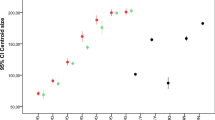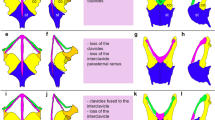Abstract
Small cursorial mammals, such as lagomorphs, elephant shrews, and the more cursorial caviomorph rodents, share both the similar locomotor gait of rapid half-bounding and a similar scapula anatomy of a long, slender, caudally projecting metacromion process. This scapular morphology is also present in some notoungulates (extinct endemic South American ungulates), in rabbit-like taxa such as Propachyruchos. In the rabbit Oryctolagus this elongated metacromion process serves to increase the moment arm of the acromiotrapezius and levator scapulae ventralis muscles, which we propose may aid in scapula stabilization and resisting ground reaction forces during the landing phase onto a single forelimb in half-bounding. A long, slender metacromion process is thus an osteological correlate of locomotor specialization, that of rapid half-bounding in small to medium-sized mammals.









Similar content being viewed by others
References
Alexander RM (1977) Terrestrial locomotion. In: Alexander RM, Goldspink G (eds) Mechanics and Energetics of Animal Locomotion. Chapman and Hall, London, pp 168–203
Bennett MB, Garden JG (2004) Locomotion and gaits of the northern brown bandicoot, Isoodon macrourus, (Marsupialia, Peramelidae). J Mammal 85:296–301
Bensley BA (1931) Practical Anatomy of the Rabbit. P. Blakiston’s Son & Co., Philadelphia
Biewener AA (1989) Scaling body support in mammals: limb posture and muscle mechanics. Science 245:45–48
Biewener AA (1998) Muscle-tendon stresses and elastic energy storage during locomotion in the horse. Comp Biochem Physiol B120:73–87
Biknevicius AR (1993) Biomechanical scaling of limb bones and differential limb use in caviomorph rodents. J Mammal 74:95–107
Bramble DM (1989) Cranial specialization and locomotor habit in the Lagomorpha. Am Zool 29:303–317
Bullimore SR, Burn JF (2005) Scaling of elastic energy storage in mammalian limb tendons: do small mammals really lose out? Biol Lett 1:57–59
Cifelli RL (1985) South American ungulate evolution and extinction. In: Stehli F, Webb SD (eds) The Great American Biotic Interchange. Plenum, New York, pp 254–257
Elissamburu A (2004) Analisis morfometrico y morfofuncional del esqueleto apendicular de Paedotherium (Mammalia, Notoungulata). Ameghiniana 41:363–380
Elissamburu A, Vizcaíno SF (2004) Limb proportions and adaptations in caviomorph rodents (Rodentia: Caviomorpha). J Zool Lond 262:145–159
Fischer MS, Blickhan R (2006) The tri-segmented limbs of therian mammals: kinematics, dynamics, and self-stabilization—a review. J Exp Biol 305A:935–952
Fischer MS, Schilling N, Schmidt M, Haarhaus D, Witte H (2002) Basic limb kinematics of small therian mammals. J Exp Biol 205:1315–1338
Gambaryan PP (1974) How Mammals Run: Anatomical Adaptations. Wiley, New York
Hildebrand M (1977) Analysis of asymmetrical gaits. J Mammal 58:131–156
Hildebrand M (1980) The adaptive significance of tetrapod gait selection. Am Zool 20:255–267
Hildebrand M (1985) Walking and running. In: Hildebrand M, Bramble DM, Liem KF, Wake DB (eds) Functional Vertebrate Morphology. Belknap, London, pp 38–75
Homberger DG, Walker WF Jr (2004) Vertebrate Dissection, 9th edn. Brooks/Cole, Thomson Learning, Belmont, CA
Howell AB (1944) Speed in Animals. University of Chicago Press, Chicago
Hucheon D, Douzery EJP (2001) From the old world to the new world: a molecular chronicle of the phylogeny and biogeography of hystricognath rodents. Mol Phylogenet Evol 20:238–251
Jenkins FA Jr (1971) Limb posture and locomotion in the Virginia opossum (Didelphis marsupialis) and in other non-cursorial mammals. J Zool Lond 165:303–315
Jenkins FA Jr (1974a) Tree shrew locomotion and the origin of primate arborealism. In: Jenkins FA Jr (ed) Primate Locomotion. Academic, New York, pp 85–115
Jenkins FA Jr (1974b) The movement of the shoulder in claviculate and aclaviculate mammals. J Morphol 144:71–84
Jenkins FA Jr, Parrington FR (1976) The postcranial skeleton of the Triassic mammals Eozostrodon, Megazostrodon, and Erythrotherium. Philos Trans R Soc B273:387–431
Jenkins FA Jr, Weijs WA (1979) The functional anatomy of the shoulder in the Virginia opossum (Didelphis virginiana). J Zool Lond 188:379–410
Kaiser HF (1960) The application of electronic computers to factor analysis. Educ Psychol Meas 20:141–151
Kingdon J (1974) East African Mammals: An Atlas of Evolution in Africa. Volume II, Part A (Insectivores and Bats). The University of Chicago Press, Chicago
Krause W (1884) Anatomie des Kaninchens. Verlag Von Wilhelm Englemann, Leipzig
Lammers AR, German RZ (2002) Ontogenetic allometry in the locomotor skeleton of specialized half-bounding mammals. J Zool Lond 258:485–495
Nowak RM (1999) Walker’s Mammals of the World, 6th edn. The Johns Hopkins University Press, Baltimore
Opazo JC (2005) A molecular timescale for caviomorph rodents (Mammalia, Hystricomorpha). Mol Phylogenet Evol 37:932–937
Richmond FJR, Liinamaa TA, Keane J, Thomson DB (1999) Morphometry, histochemistry, and innervation of cervical shoulder muscles in the cat. J Morphol 239:255–269
Rowe DL, Honeycutt RL (2002) Phylogenetic relationships, ecological correlates, and molecular evolution within the Cavoidea (Mammalia, Rodentia). Mol Biol Evol 19:263–277
Ruff C (1990) Body mass and hindlimb bone cross-sectional and articular dimensions in anthropoid primates. In: Damuth J, MacFadden BJ (eds) Body Size in Mammalian Paleobiology: Estimation and Biological Implications. Cambridge University Press, Cambridge, pp 119–149
Ruina A, Bertram JEA, Srinivasan M (2005) A collisional model of the energetic cost of support work qualitatively explains leg sequencing in walking and galloping, pseudo-elastic leg behavior in running and the walk-to-run transition. J Theor Biol 237:170–192
Savage RJG, Long MR (1986) Mammal Evolution: A Illustrated Guide. British Museum (Natural History) Publishing, London
Sears KE (2004) Constraints on the morphological evolution of marsupial shoulder girdles. Evolution 58:2353–2370
Sereno PC, McKenna MC (1995) Cretaceous multituberculate skeleton and the early evolution of the mammalian shoulder girdle. Nature 377:144–147
Sinclair WJ (1909) Typotheria of the Santa Cruz beds. In: Scott WB (ed) Reports of the Princeton University Expeditions to Patagonia, 1896–1899. Princeton University Press, Princeton, pp 1–110
Smith FA, Lyons SK, Ernest SKM, Jones KE, Kauffman DM, Dyan T, Marquet PA, James JH, Haskell JP (2003) Body mass of late Quaternary mammals. Ecology 84:3403
Vaughan TA, Ryan JM, Czaplewski NJ (2000) Mammalogy, 4th edn. Saunders College Publishing, Fort Worth
Williams SB, Wilson AM, Payne C (2007) Functional specialisation of the thoracic limb of the hare (Lepus europaeus). J Anat 201:491–505
Wilson AM, McGuigan MP, Su A, van den Bogert AJ (2001) Horses damp the spring in their step. Nature 414:895–898
Witte H, Biltzinger J, Hackert R, Schilling N, Schmidt M, Reich C, Fischer MS (2002) Torque patterns of the limbs of small therian mammals during locomotion on flat ground. J Exp Biol 205:1339–1353
Acknowledgements
We thank Manuel Mendoza for help with statistics, and Judy Chupasko (Harvard University Museum of Comparative Zoology), Eileen Westwig (American Museum of Natural History), and Richard Thorington (Smithsonian Institution) for access to specimens in their care. Thanks also to members of the Brown University Morphology Group for discussion of this manuscript, especially to Beth Brainerd and Tonia Hsieh for written comments, Tom Roberts for suggestion of references, and useful comments from two reviewers and the journal editor. An earlier version of this paper comprised the Brown University undergraduate honors thesis for the senior author.
Author information
Authors and Affiliations
Corresponding author
Appendix
Appendix
Rights and permissions
About this article
Cite this article
Seckel, L., Janis, C. Convergences in Scapula Morphology among Small Cursorial Mammals: An Osteological Correlate for Locomotory Specialization. J Mammal Evol 15, 261–279 (2008). https://doi.org/10.1007/s10914-008-9085-7
Received:
Accepted:
Published:
Issue Date:
DOI: https://doi.org/10.1007/s10914-008-9085-7




